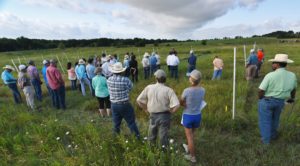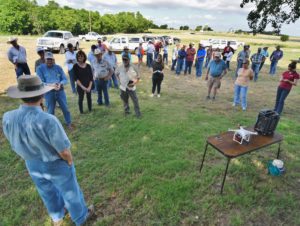Temple center welcomes producers, industry professionals during field day
- Writer: Adam Russell, 903-834-6191, [email protected]
- Contact: Dr. Tom Gerik, 254-774-6128, [email protected]
TEMPLE – The Texas A&M AgriLife Research and Extension Center and U.S. Department of Agriculture Grassland Soil and Water Research Laboratory, which operate on the same campus in Temple, recently opened their doors to more than 60 area producers and agriculture industry professionals during their second annual field day.

Attendees toured the 600-acre facility to hear presentations by Texas A&M AgriLife Research and USDA Agricultural Research Service staff regarding projects ranging from native prairies to the use of remote-sensing technology in agriculture to spacing and soil fertility trials in cotton to wheat, oat and barley.
Dr. Tom Gerik, AgriLife center director at Temple, said the field day is a great opportunity to meet with area producers, allow them access to facilities and staff and discuss how technology and research can benefit them now and in the future, including precision farming using the latest technologies to maximize efficiencies.
“It was a successful day,” he said. “It was a good opportunity to introduce producers to the future of farming. Precision farming is that future, and I think producers are open to technology because they see it as a way to manage their land to its utmost potential.”
During tours of the facilities, producers were introduced to the use of unmanned aerial vehicles, or drones, that can be used to monitor fields to glean a full range of information, such as disease or pest presence or soil temperature and moisture, or mapped for yield potential based on soil conditions and data from previous growing seasons.
Producers were introduced to seed and fertilizer application technology that can reduce waste, such as from overplanting, which can waste seed and reduce yields as improperly spaced plants compete for resources.

“It’s about productivity and how efficiently can you produce your crops,” Gerik said. “We’re talking millions of acres for various crops across Texas. So, reducing the per-acre costs to producers while increasing the productivity of those acres — and all of that while making positive environmental impacts by making herbicide, pesticide and fertilizer applications more effective — it’s going to be huge.”
Producers were also introduced to potential growing options, including barley and new wheat varieties as they toured ongoing research trials.
“We’re always looking for another option for growers,” Gerik said. “There are niche markets that growers can capitalize on if they know what performs well and the production processes necessary to make it an economically viable crop. We’re here to provide that information alongside our USDA-ARS counterparts.”
Gerik said he is proud of the ongoing cooperative efforts between AgriLife Research and USDA-ARS and USDA-Natural Resources Conservation Service scientists and appreciates their important role in the field day.
“We’re so closely aligned with what they are doing here at the Blacklands Center,” he said. “It really is an amazing model for cooperation that works to the benefit of our producers, consumers and the environment.”


